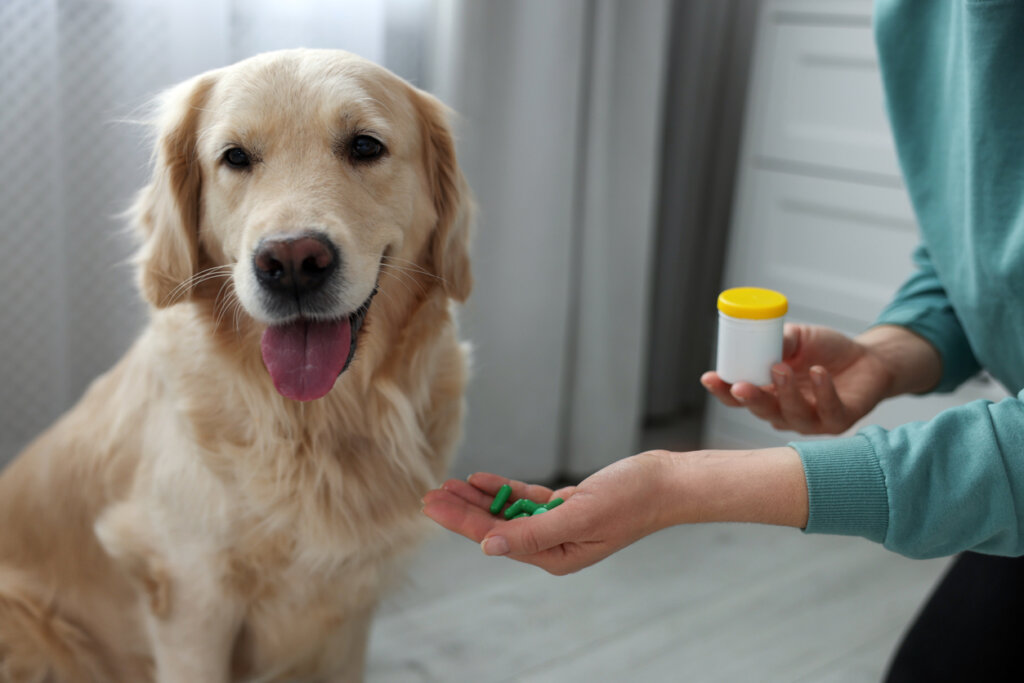Progestogens in Dogs: Is it Risky to Use Them?

The use of progestogens in dogs as a contraceptive method aims to inhibit the onset of estrus in unoperated female dogs. However, in spite of fulfilling its objective, this practice is considered risky due to the number of adverse effects it can produce.
For this reason, both veterinarians and responsible veterinarians should rethink its administration for the control of reproductive cycles in female dogs. Continue reading to get to know all the aspects related to the use of these hormones in pets.
Estrus cycle in bitches
Before starting with such a significant topic for health, it’s important to review part of the reproductive process of female dogs. First, estrus is defined as the state in which a bitch is receptive for mating.
This period occurs when sexual maturity is reached, which is achieved between 8 and 15 months of age depending on the breed of the individual. Unlike other animal species, estrus in bitches is non-seasonal mono sex. That is, there is only one estrus per estrous cycle and it occurs at any time of the year.
This phenomenon usually occurs every 6 to 12 months, although in some breeds such as the German Shepherd, it can occur every 4 months. This reproductive period has 4 phases or stages:
Phases of estrus
- Proestrus: This is the first phase of the estrous cycle. It lasts from 3 to 20 days and is characterized by the beginning of bleeding in the bitch and by an increase in the size of the vulva. During this period, follicular growth begins, thanks to follicle-stimulating hormone (FSH).
- Estrous: Stage in which the bitch becomes receptive to mating. Although there’s no standard length of time, this stage persists from 3 to 20 days, with a general average of 9 days. Thanks to the action of estrogens and progesterone, ovulation occurs 24 to 48 hours after the onset of estrus.
- Diestrous: Also known as the luteal phase, it begins when the female no longer accepts the male. If conception has occurred, this stage lasts about 63 days. On the other hand, if there’s no gestation, it lasts 100 days on average.
- Anestrus: This is the period between the end of diestrous and the beginning of proestrus. In more practical terms, it’s a stage of reproductive inactivity.
Having identified the different stages of the sexual cycle in bitches, let’s review what progestogens are, their classification, and their use in the field of veterinary medicine.

What are progestogens?
Progestogens are a group of steroidal hormones with important activity in the processes of gestation and estrus in bitches. Their main function is to prepare the endometrium for implantation and maintenance of pregnancy. They also inhibit uterine motility during pregnancy and stimulate the development of mammary tissue.
In addition, they act together with estrogens to induce estrous behavior or estrus. According to their origin, they can be classified as follows:
- Progesterone: The body produces it naturally. The corpora lutea synthesize and secrete this hormone during the luteal phase of the estrous cycle. The placenta takes care of this function during pregnancy. Due to its rapid metabolization, it’s of little use in the medical field.
- Progestins: These are synthetic drugs used for therapeutic purposes, as they have similar effects to progesterone. Among the main ones are medroxyprogesterone acetate (MPA), megestrol acetate (MA) and chlormadinone.
What are the uses of progestogens in dogs?
Progestogens have been used for the treatment of various pathologies of behavioral and dermatological origin in dogs. However, the field of greatest application is reproductive control.
According to research, the first studies evaluating the effect of progestins in suppressing the estrous cycle in bitches date back to 1952. Since then, a large number of practitioners have employed these drugs as contraceptive methods.
As we have noted, progestins play a critical role during estrous and pregnancy events. However, it has been shown that at high doses or with prolonged exposure, an inhibition in the synthesis and release of gonadotropins is generated.
It’s important to bear in mind that follicle-stimulating hormone (FSH) and luteinizing hormone (LH) – which are part of the gonadotropin group – are necessary for the appearance of the phases of the estrous cycle and, therefore, of ovulation.
Regarding treatment, there are 3 ways of suppressing the estrous cycle with progestins. For the use of these drugs, the duration, the purpose, and the phase in which they’re administered are considered:
- Acute suppression: In the first case, progestins are administered at high doses before or during early proestrus, with the aim of suppressing both proestrus and estrus. In addition, it has an effect that delays the estrous cycle for several weeks or months.
- Temporary suppression: To achieve a temporary inhibition of the new cycle, progestins are administered at low doses, for several weeks during the anestrus stage.
- Permanent suppression: Prolonged administration of progestin, initiated in anestrus, can delay the onset of the next cycle for several months. To do this, repeated oral administrations, injections of short-acting formulation, as well as long-acting ones, are performed. The duration of the effect is multiple cycles.
It should be noted that, as in humans, when these hormones are stopped orally or by injection, reproductive cycles return to normal.
Is it risky to use progestogens in dogs? Side effects
Although these drugs fulfill their function, depending on the case of their administration, they generally cause undesirable metabolic and morphological changes in the dog’s body.
According to an article published in the journal Topics in Companion Animal Medicine, administration of progestins increases the risk of reproductive diseases, such as cystic endometrial hyperplasia or mammary tumors.

Likewise, their application has been related to the development of liver problems, hormonal disorders due to adrenocortical suppression, skin diseases, and symptoms of insulin-resistant diabetes.
On the other hand, in more serious cases, progestins in dogs can compromise the patient’s life. This is because they can generate what is known as pyometra, a condition in which there’s production and accumulation of purulent material inside the uterus. In addition, if it’s applied in females that have been pregnant, there’s a risk of fetal death and mummification.
In either case, the only solution is surgery to remove the compromised uterus, with the consequent permanent infertility in the dog.
Recommendations for pet owners
Undoubtedly, the use of progestogens in dogs generates more harm than good. To date, there’s no safe contraceptive drug in veterinary medicine, since all the products on the market produce this type of side effect in one way or another.
In fact, the administration of certain drugs in canines, such as medroxyprogesterone acetate (MPA), is prohibited in the United States. For this reason, the main option in case a person does not want their pet to reproduce is sterilization or ovariohysterectomy.
Thanks to this procedure, owners will not only prevent pregnancy in their pets, but will also avoid the characteristic symptoms of estrus such as vaginal bleeding or behavioral changes.
In addition, studies suggest that this surgery decreases the risk of reproductive disorders such as mammary tumors. Finally, for owners who do not want to submit their pet to an ovariohysterectomy and at the same time avoid pregnancy in their dog, the recommendation is isolation and strict care.
All cited sources were thoroughly reviewed by our team to ensure their quality, reliability, currency, and validity. The bibliography of this article was considered reliable and of academic or scientific accuracy.
- De Pedro, J. (2006). Anticoncepción en perros y gatos. Farmacia profesional, 20 (6), 70-72. https://www.elsevier.es/es-revista-farmacia-profesional-3-articulo-anticoncepcion-perros-gatos-13089956
- Domínguez, M., & Maldonado, J. (2006). Gestación prolongada asociada con la prescripción inadecuada de medroxiprogesterona acetato. ¿Es racional y ético el uso de progestágenos exógenos en perras. Revista Colombiana de Ciencias Pecuarias, 19 (4). http://www.scielo.org.co/scielo.php?script=sci_arttext&pid=S0120-06902006000400010#:~:text=Los%20progest%C3%A1genos%20sint%C3%A9ticos%20como%20la,tumores%20mamarios%20y%20uterinos%2C%20complejo
- Echeverria, J. (2005). Aspectos farmacológicos en el manejo reproductivo de la perra. Revisión bibliográfica. Revista electronica de veterinaria, 6 (3). https://www.redalyc.org/pdf/636/63612812002.pdf
- Geil, R. G., & Lamar, J. K. (1977). FDA studies of estrogen, progestogens, and estrogen/progestogen combinations in the dog and monkey. Journal of toxicology and environmental health, 3(1-2), 179–193. https://pubmed.ncbi.nlm.nih.gov/411941/
- Hagman R. (2022). Pyometra in Small Animals 2.0. The Veterinary clinics of North America. Small animal practice, 52(3), 631–657. https://www.vetsmall.theclinics.com/article/S0195-5616(22)00004-3/fulltext
- Kutzler M. A. (2007). Estrus induction and synchronization in canids and felids. Theriogenology, 68(3), 354–374. https://www.sciencedirect.com/science/article/abs/pii/S0093691X07001446?via%3Dihub
- Kutzler, M. A. (2018). Estrus Suppression in Dogs. The Veterinary clinics of North America. Small animal practice, 48(4), 595–603. https://linkinghub.elsevier.com/retrieve/pii/S0195-5616(18)30027-5
- Misdorp, W. (1991). Progestagens and mammary tumours in dogs and cats. Acta endocrinologica, 125 Suppl 1, 27–31. https://pubmed.ncbi.nlm.nih.gov/1839343/
- Mutembei, H. M., Mutiga, E. R., & Tsuma, V. T. (2000). A retrospective study on some reproductive parameters of German shepherd bitches in Kenya. Journal of the South African Veterinary Association, 71(2), 115–117. https://www.researchgate.net/publication/12294740_A_retrospective_study_on_some_reproductive_par
- National Toxicology Program (2011). Progesterone. Report on carcinogens : carcinogen profiles, 12, 362–364. https://www.ncbi.nlm.nih.gov/books/NBK590824/
- Romagnoli, S., & Concannon , P. (2003). Uso clínico de progestinas en perras y gatas: una revisión. Recent Advances in Small Animal Reproduction. https://www.ivis.org/library/recent-advances-small-animal-reproduction/uso-cl%C3%ADnico-de-progestinas-en-perras-y-gatas-una
- Sleeckx, N., de Rooster, H., Veldhuis Kroeze, E. J., Van Ginneken, C., & Van Brantegem, L. (2011). Canine mammary tumours, an overview. Reproduction in domestic animals = Zuchthygiene, 46(6), 1112–1131. https://onlinelibrary.wiley.com/doi/10.1111/j.1439-0531.2011.01816.x
- Torres, C. (2013). Uso de progestágenos como anovulatorios en caninos. Universidad Autónoma Agraria Antonio Narro. http://repositorio.uaaan.mx:8080/xmlui/bitstream/handle/123456789/7043/CLAUDIA%20TORRES%20HERRERA.pdf?sequence=1&isAllowed=y
- Wiebe, V. J., & Howard, J. P. (2009). Pharmacologic advances in canine and feline reproduction. Topics in companion animal medicine, 24(2), 71–99. https://www.ncbi.nlm.nih.gov/pmc/articles/PMC7104932/
